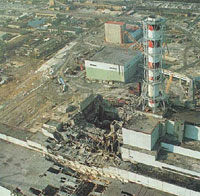
The Chernobyl disaster was a nuclear reactor accident in the Chernobyl Nuclear Power Plant in the Soviet Union.
It is so far the worst nuclear power plant accident in history and the only level 7 instance on the International Nuclear Event Scale,
resulting in a severe release of radioactivity into the environment following a massive power excursion which destroyed the reactor.
Two people died in the initial steam explosion, but most deaths from the accident were attributed to fallout.
On 26 April 1986 at 01:23:45 a.m. (UTC+3) reactor number four at the Chernobyl plant, near Pripyat in the
Ukrainian Soviet Socialist Republic, exploded. Further explosions and the resulting fire sent a plume of
highly radioactive fallout into the atmosphere and over an extensive geographical area.
Four hundred times more fallout was released than had been by the atomic bombing of Hiroshima.
The plume drifted over extensive parts of the western Soviet Union, Eastern Europe, Western Europe,
Northern Europe, and eastern North America. Large areas in Ukraine, Belarus, and Russia were badly contaminated,
resulting in the evacuation and resettlement of over 336,000 people. According to official post-Soviet data,
about 60% of the radioactive fallout landed in Belarus.
The accident raised concerns about the safety of the Soviet nuclear power industry, slowing its expansion
for a number of years, while forcing the Soviet government to become less secretive. The now-independent countries
of Russia, Ukraine, and Belarus have been burdened with the continuing and substantial decontamination and
health care costs of the Chernobyl accident. It is difficult to accurately tell the number of deaths
caused by the events at Chernobyl, as the Soviet-era cover-up made it difficult to track down victims.
Lists were incomplete, and Soviet authorities later forbade doctors to cite "radiation" on death certificates.
The overall cost of the disaster is estimated at $200 billion USD, taking inflation into account.
This places the Chernobyl disaster as one of the costlier disasters in modern history.
The 2005 report prepared by the Chernobyl Forum, led by the International Atomic Energy Agency (IAEA)
and World Health Organization (WHO), attributed 56 direct deaths (47 accident workers, and nine children
with thyroid cancer), and estimated that there may be 4,000 extra cancer deaths among the approximately 600,000
most highly exposed people. Although the Chernobyl Exclusion Zone and certain limited areas will remain off limits,
the majority of affected areas are now considered safe for settlement and economic activity.
|